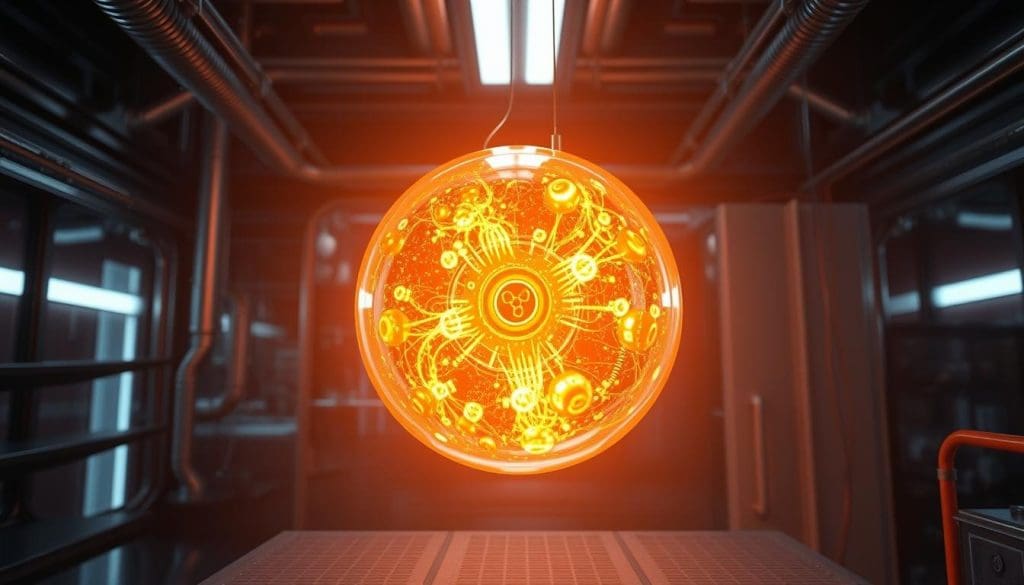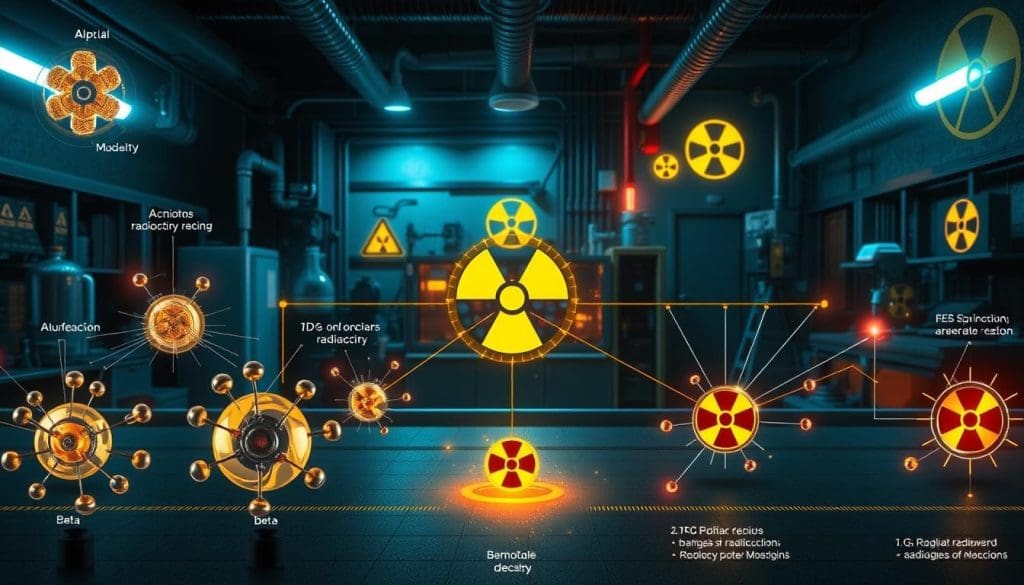Last Updated on November 27, 2025 by Bilal Hasdemir

Learning about radioactive half-life is key in science, like chemistry, geology, and medicine. The concept of radioactive half-life explains how long it takes for half of the atoms in a sample to decay. This is a basic yet crucial idea in scientific research and applications.
We’ll dive into what half-life means, why it matters, and how it’s used. Knowing this helps scientists and doctors predict how things will break down. This knowledge is important for making good choices in their work.
Key Takeaways
- Understanding the concept of radioactive half-life is vital in chemistry and science.
- Half-life is a fundamental concept in nuclear physics, describing the time required for half of the atomic nuclei to undergo radioactive decay.
- Knowledge of half-life is critical for predicting decay patterns and making informed decisions.
- Applications of half-life can be seen in various fields, including geology, medicine, and nuclear energy.
- Understanding half-life is essential for scientists and medical professionals to make accurate predictions and decisions.
The Fundamentals of Radioactive Half Life in Science

Half-life is key to understanding how radioactive materials decay. It’s a basic idea in chemistry and physics. It shows how fast unstable isotopes lose their radioactivity over time.
Definition of Half Life in Chemistry and Nuclear Physics
In nuclear physics and chemistry, half-life is the time it takes for half of a radioactive substance’s atoms to decay. This idea is vital for knowing how stable and long-lasting radioactive isotopes are. The half-life concept is central to nuclear chemistry.
The Symbol for Half Life and Standard Notation
The half-life is shown as t1/2. This symbol is used everywhere in nuclear physics and chemistry. It shows the time it takes for a radioactive isotope’s activity to drop by half. Knowing this symbol is key for using half-life data in science.
The Probabilistic Nature of Decay Events
Radioactive decay is a probabilistic process at the atomic level. You can’t predict when a single atom will decay. But, for many atoms, the decay probability can be predicted, leading to the half-life concept. This randomness is why half-life is always the same for each radioactive isotope, no matter what. For more on radioactive half-life.
The Science Behind Radioactive Decay Processes

Learning about radioactive decay is key in nuclear chemistry. It’s how unstable atoms lose energy by sending out particles or waves. This is a big deal in nuclear physics and helps us understand matter.
Types of Radioactive Decay Mechanisms
There are several ways radioactive decay can happen. The main ones are alpha, beta, and gamma decay. Alpha decay happens when heavy elements like uranium lose an alpha particle. Beta decay is when a neutron turns into a proton or vice versa, sending out a beta particle. Gamma decay is when a nucleus sends out gamma rays to reach a lower energy state.
Stable vs. Unstable Isotopes in Nuclear Chemistry
Isotopes are different versions of the same element, with the same number of protons but varying neutrons. Some isotopes are stable, while others are radioactive. The stability depends on the balance of protons and neutrons in the nucleus.
Isotopes with too many or too few neutrons are unstable. They decay to become more stable. This is important in nuclear chemistry.
| Isotope Type | Stability | Decay Mode |
| Stable Isotopes | Stable | No decay |
| Neutron-rich Isotopes | Unstable | Beta minus decay |
| Neutron-poor Isotopes | Unstable | Beta plus decay or Electron Capture |
In summary, knowing about radioactive decay and isotope stability is vital. It helps us understand nuclear chemistry better. By learning these concepts, we can appreciate the complex ways radioactive materials behave.
Mathematical Expressions: The Half-Life Formula Explained
Understanding half-life is key to grasping how radioactive materials decay. The half-life formula is at the core of this. It helps us figure out how much of a radioactive substance is left after a certain time.
The Decay Constant and Its Relationship to Half Life
The decay constant (λ) is vital in studying radioactive decay. It shows how likely a nucleus is to decay in a given time. The formula tâ‚/â‚‚ = ln(2) / λ shows that half-life is the opposite of the decay constant.
As stated by
“The decay constant is a measure of the rate at which a radioactive substance decays.”
This rate is built into the isotope itself. It doesn’t change with temperature or pressure.
First-Order Kinetics in Radioactive Decay
Radioactive decay is a first-order kinetics process. This means the decay rate is directly tied to the amount of substance. The formula N(t) = N₀e^(-λt) shows this relationship, where N(t) is the substance at time t, N₀ is the starting amount, and λ is the decay constant.
The Math Half Life Formula: N = Nâ‚€(1/2)^(t/tâ‚/â‚‚)
The math half-life formula makes it easy to find out how much of a substance is left after a few half-lives. The formula is N = Nâ‚€(1/2)^(t/tâ‚/â‚‚). Here, N is the final amount, Nâ‚€ is the starting amount, t is the time passed, and tâ‚/â‚‚ is the half-life.
Calculating Material Remaining After One Half Life
After one half-life, half of the substance remains. Using the formula, we see that starting with Nâ‚€ nuclei, after one half-life (t = tâ‚/â‚‚), we have N = Nâ‚€(1/2)^(tâ‚/â‚‚/tâ‚/â‚‚) = Nâ‚€/2 nuclei left. This method works for figuring out the amount left after more half-lives.
Understanding Radioactive Half Life Measurements
Radioactive half-life measurements are key in fields like nuclear physics and chemistry. They show how fast radioactive isotopes decay. This knowledge is vital for medicine, geology, and energy.
Experimental Methods for Determining Half Life Values
To find a radioactive isotope’s half-life, scientists use different methods. For short-lived isotopes, they use delayed coincidence measurements and time-resolved spectroscopy. For longer-lived ones, gamma-ray spectroscopy and mass spectrometry are better.
These methods help us get accurate half-life values. The right method depends on the isotope’s decay and energy release.
| Experimental Method | Half-Life Range | Typical Isotopes |
| Delayed Coincidence | nanoseconds to seconds | Na, Co |
| Gamma-Ray Spectroscopy | hours to years | Cs, I |
| Mass Spectrometry | years to millions of years | U, Th |
The Range of Half Lives in Nature
Radioactive isotopes have half-lives from fractions of a second to billions of years. This shows how different isotopes are in terms of stability. For example, Be decays in about 10^-16 seconds, while Te takes around 2.2 x 10^24 years.
Knowing this range is important for many uses, like nuclear medicine and dating rocks. We pick isotopes based on their half-life for the best results.
Understanding half-life measurements and their range helps us see the complexity of radioactive decay. It’s key in many scientific fields.
Applications of Half Life in Geology and Earth Sciences
In geology, half-life is key for dating rocks and fossils. It helps scientists figure out how old they are. This is done through radiometric dating, which uses the decay of radioactive isotopes.
Radiometric Dating Techniques in Geology
Radiometric dating works by tracking how fast radioactive isotopes decay. This rate is linked to their half-life. By measuring the isotopes, scientists can find out how old a sample is.
Isotopes have different half-lives, making some better for certain samples. For example, Uranium-238 is used for rocks that are millions to billions of years old. On the other hand, Carbon-14 is for dating organic materials up to 50,000 years old.
Using Geology Half Life Principles for Dating Rocks
The half-life principle is essential for dating rocks. Geologists use it to find out when a rock was formed. They measure the isotopes and use the half-life to calculate the age.
The accuracy of dating rocks depends on several things. These include how well the isotopes are measured and if the sample has been changed over time.
Limitations and Accuracy Considerations
Radiometric dating is very useful but has its limits. It assumes the decay rate has always been the same and the sample is pure. Also, it needs a lot of sample material and special equipment.
To get accurate results, geologists often use more than one dating method. This way, they can check their findings and get a more reliable age.
By using half-life and radiometric dating, geologists can learn about Earth’s history. They can find out when big geological events happened and how life evolved.
Medical and Biological Applications of Half Life
Understanding half-life is key for safe use of radioisotopes in medicine. Radioisotopes are vital in both imaging and treatments, changing nuclear medicine a lot.
Diagnostic Imaging with Radioisotopes
Radioisotopes help in many imaging methods, like PET and SPECT scans. These scans use half-life to show body structures and functions clearly. For example, Technetium-99m is used in SPECT scans because of its short half-life and right gamma radiation.
The right radioisotope is picked based on the task, looking at half-life, radiation type, and energy. Short-lived isotopes help keep radiation risk low for patients.
Radiation Therapy and Treatment Planning
In cancer treatment, radioisotopes target tumors with radiation. The isotope’s half-life is key for planning, as it shows how long it works. Iodine-131 is used for thyroid cancer because of its short half-life and specific thyroid uptake.
Knowing half-life helps plan treatment timing and dose. This ensures the tumor gets enough radiation while protecting healthy tissues.
Biological Half Life vs. Physical Half Life
It’s important to know the difference between biological and physical half-lives in medicine. Physical half-life is how long it takes for radioactivity to drop by half through decay. Biological half-life is how long it takes for the body to remove half of the radioactive substance.
The effective half-life, combining both, is key for assessing radioisotope risk and effectiveness. We must consider both to ensure safe use of radioisotopes.
Nuclear Energy and Radioactive Half Life Considerations
Radioactive half-life is key in nuclear energy, affecting fuel cycles and waste management. We’ll look at how half-life impacts nuclear energy production. This includes the challenges and considerations due to the fuel’s radioactive nature.
Fuel Cycles in Nuclear Reactors
Nuclear reactors use radioactive isotopes like uranium-235 or plutonium-239 for energy. The half-life of these isotopes is vital for reactor efficiency and safety.
Uranium-235 has a half-life of about 703.8 million years. This long half-life means the fuel stays radioactive for a long time. It requires careful handling and storage before and after reactor use.
| Isotope | Half-Life | Application in Nuclear Energy |
| Uranium-235 | 703.8 million years | Fuel for nuclear reactors |
| Plutonium-239 | 24,100 years | Fuel for nuclear reactors and nuclear weapons |
Nuclear Waste Management Challenges
Nuclear waste management is a big challenge for the nuclear energy industry. The waste stays hazardous for thousands to millions of years, based on the isotopes.
Storing and disposing of nuclear waste need special facilities. These facilities must keep the waste away from the environment and prevent leaks. The half-life of the isotopes determines how long the waste needs to be stored.
Decay Chains and Daughter Products
Radioactive decay is a series of decays, called a decay chain. The parent isotope decays into daughter products, which may also be radioactive. Understanding these chains is key for managing nuclear waste and ensuring long-term safety.
For example, uranium-238 decays into thorium-234, then into protactinium-234, and so on. Each step has its own half-life, affecting the waste’s radioactivity over time.
By understanding half-life, decay chains, and nuclear waste challenges, we can improve nuclear energy production. This leads to safer, more sustainable practices in this critical sector.
Practical Examples: Half Life Calculations in Science
In nuclear physics, half-life calculations are key. They help figure out the age of old samples and predict how much radiation they will give off. These calculations are vital for understanding how radioactive materials change over time.
Determining Age Using Half Life Principles
Half-life calculations are very important in radiometric dating. Scientists use them to find out how old a sample is by measuring the leftover radioactive isotopes. For example, carbon-14 dating is used a lot in archaeology.
It works because carbon-14 has a half-life of about 5,730 years. This lets researchers figure out how old a sample is by comparing the carbon-14 to carbon-12 levels.
Let’s say a sample has 25% of the original carbon-14 left. We can work out its age. Because it’s gone through two half-lives, and knowing one half-life is 5,730 years, the sample is 11,460 years old.
Predicting Radiation Levels Over Time
Half-life calculations are also key for figuring out how much radiation something will give off over time. This is really important in fields like nuclear medicine and energy.
For example, with iodine-131, which has a half-life of about 8 days, we can predict its radiation levels. If it starts at 100%, after 8 days it’s at 50%, after 16 days at 25%, and so on. This info is critical for safe handling and for managing nuclear waste.
Multiple Half Lives and Exponential Decay Patterns
It’s important to understand how substances with multiple half-lives decay. They decay exponentially, meaning the rate of decay changes based on how much is left. This leads to a specific curve of decay.
For example, if we start with 1,000 grams of a substance with a 10-year half-life, after 10 years we have 500 grams. After 20 years, 250 grams, and after 30 years, 125 grams. This shows how the decay is exponential.
By using half-life calculations, scientists can accurately predict how radioactive materials will behave. This is essential for many scientific and practical uses.
Conclusion: The Significance of Half Life in Modern Science
We’ve looked into the key idea of radioactive half-life and its wide impact in science. Half-life is important because it helps us measure how fast radioactive materials decay. This is key for using these materials in science, medicine, and tech.
In today’s science, the symbol for half-life, tâ‚/â‚‚, is used everywhere. It has led to big discoveries in geology, like figuring out rock ages and Earth’s past.
In medicine, half-life is critical for imaging and treating diseases with radioisotopes. It’s also key in nuclear energy for designing reactors and handling waste.
As we learn more about radioactive decay, half-life will keep being a core part of science. It will keep pushing innovation and discovery in many areas.
FAQ
What is the definition of half-life in chemistry?
Half-life is the time it takes for half of the atoms in a radioactive isotope to decay.
What is the symbol for half-life?
The symbol for half-life is tâ‚/â‚‚.
How is half-life related to the decay constant?
The decay constant (λ) is related to half-life (tâ‚/â‚‚) by the formula: tâ‚/â‚‚ = ln(2) / λ.
What is the difference between biological half-life and physical half-life?
Biological half-life is how long it takes for the body to remove half of a radioactive substance. Physical half-life is how long it takes for half of the atoms in a sample to decay.
How is half-life used in radiometric dating?
Half-life is used in radiometric dating to find the age of rocks and geological events. It measures the amount of radioactive isotopes and their decay products.
What is the half-life formula for calculating the amount of material remaining?
The formula is: N = Nâ‚€(1/2)^(t/tâ‚/â‚‚), where N is the amount left, Nâ‚€ is the initial amount, t is time, and tâ‚/â‚‚ is the half-life.
How do scientists measure half-life values?
Scientists measure half-life values by counting decay events over time.
What are the challenges in measuring very short or very long half-lives?
Measuring very short half-lives needs advanced equipment to quickly detect decay. Measuring very long half-lives requires patience and precise measurements over long periods.
How is half-life relevant to nuclear energy production?
Half-life is key in nuclear energy for understanding fuel cycles, managing waste, and dealing with decay chains and daughter products.
What is the significance of half-life in medical applications?
Half-life is important in medicine for diagnostic imaging and radiation therapy. It helps in treatment planning and understanding radioactive substances in the body.
References
- Usanase, N. (2024). A look at radiation detectors and their applications in healthcare. https://pubmed.ncbi.nlm.nih.gov/37733205/






